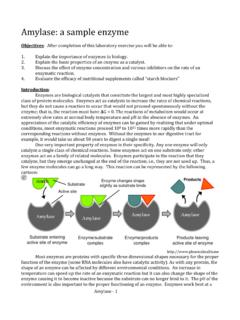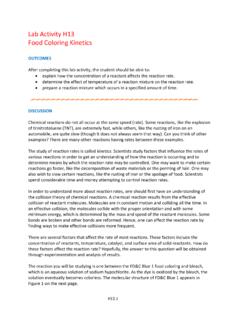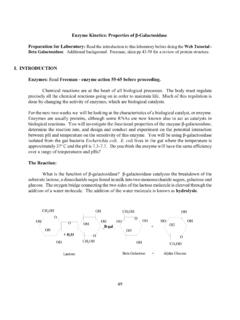Transcription of Amylase: a sample enzyme - Bio 111 and 112 Home Page
1 amylase - 1 amylase : a sample enzyme Objectives: After completion of this laboratory exercise you will be able to: 1. Explain the importance of enzymes in biology. 2. Explain the basic properties of an enzyme as a catalyst. 3. Discuss the effect of enzyme concentration and various inhibitors on the rate of an enzymatic reaction. 4. Evaluate the efficacy of nutritional supplements called starch blockers Introduction: Enzymes are biological catalysts that constitute the largest and most highly specialized class of protein molecules. Enzymes act as catalysts to increase the rates of chemical reactions , but they do not cause a reaction to occur that would not proceed spontaneously without the enzyme ; that is, the reaction must have G < 0.
2 The reactions of metabolism would occur at extremely slow rates at normal body temperature and pH in the absence of enzymes. An appreciation of the catalytic efficiency of enzymes can be gained by realizing that under optimal conditions, most enzymatic reactions proceed 108 to 1011 times more rapidly than the corresponding reactions without enzymes. Without the enzymes in our digestive tract for example, it would take us about 50 years to digest a single meal! One very important property of enzymes is their specificity. Any one enzyme will only catalyze a single class of chemical reactions . Some enzymes act on one substrate only; other enzymes act on a family of related molecules.
3 Enzymes participate in the reaction that they catalyze, but they emerge unchanged at the end of the reaction, , they are not used up. Thus, a few enzyme molecules can go a long way. This reaction can be represented by the following cartoon: Most enzymes are proteins with specific three dimensional shapes necessary for the proper function of the enzyme (some RNA molecules also have catalytic activity ). As with any protein, the shape of an enzyme can be affected by different environmental conditions. An increase in temperature can speed up the rate of an enzymatic reaction but it can also change the shape of the enzyme causing it to become inactive because the substrate can no longer bind to it.
4 The pH of the environment is also important to the proper functioning of an enzyme . Enzymes work best at a amylase starch amylase amylase amylase amylase - 2 specific pH and a change in this value can also cause the enzyme to denature (change its shape) and become inactive. In this lab we will demonstrate the hydrolysis of starch to glucose using the enzyme amylase which is found in saliva and in secretions from the pancreas. Starch (also known as amylose) is a polymer made from many glucose molecules connected together in a long chain via covalent bonds. It is produced by dehydration synthesis and is used by many organisms as a way to store glucose for later use. Its structure is shown in figure 1 (right).
5 For organisms to be able to use the energy in starch the polymer must be broken down into its simpler glucose units. In animals, this hydrolysis reaction is catalyzed by the enzyme amylase . In fact, amylase converts starch to glucose dimers (called maltose) and trimmers (called maltotriose); these are then converted by other enzymes to glucose which can then be used for cellular respiration, etc. We will study the effect of enzyme concentration on the rate of the conversion of starch to maltose. There are a variety of nutritional supplements that call themselves starch blockers . Their manufacturers claim that they contain extracts from the common bean (Phaseolus vulgaris) that inhibit amylase .
6 Beans are known to contain amylase inhibitors these are proteins that bind to the active site of amylase and prevent it from catalyzing the breakdown of starch. However, the supplement industry is very lightly regulated, so manufacturers are able to make claims of efficacy without having to provide evidence to support these claims. As a result, not all supplements claiming to be starch blockers will necessarily contain amylase inhibitors. In this lab, we will measure one or more starch blockers to see if in fact they do inhibit amylase . The action of amylase on starch can be readily followed with the IKI (a mixture of iodine and potassium iodide) test. IKI stains starch a blue-black color, but it does not stain maltose or maltotriose.
7 When all of the starch has been hydrolyzed to these sugars, the solution will remain the yellowish-brown color of IKI. As hydrolysis is taking place and some of the starch has been hydrolyzed and some has not, the solution will show intermediate shades of brownish-black. The diagram below shows these changes. Please note that a positive test for starch means that the enzyme has not broken down all of the starch in the sample yet and a negative test for starch means that the enzyme has broken down all of the starch in the sample to sugars. 1. START: only un-hydrolyzed starch (BLUE-BLACK) 2. {some starch hydrolyzed to maltose} 3. MIDDLE: Mixture of starch and glucose (BROWN-BLACK) 4.
8 {finally, all the starch has been hydrolyzed to maltose} 5. END: No starch; only maltose (YELLOW-BROWN) Time amylase - 3 Procedure PART 0: PIPETTE PRACTICE You should practice using pipettes to measure precise volumes of water into a test tube until you re sure you can do it quickly and repeatably. The best practice is to show that you can add and subtract volumes accurately for example, put two samples of each into a test tube and be sure that you can pipette out exactly 5ml. PART I: REACTION RATE VS. enzyme CONCENTRATION 0. Guide to colors: Each group should prepare one spot plate with a drop of IKI test solution in each of two of the depressions. To one of the IKI drops, add a drop of starch solution.
9 Record the colors and make it clear in your notes what happened in each case. The depression with the IKI only is the standard or reference that shows the color of the solution when no starch is present and the depression with the drop of starch is the standard that shows the color of the solution when high amounts of starch are present. 1. Label 3 test tubes SS for Stock Starch and your group name. Pipette 4 ml of the stock starch solution into each test tube. Be as accurate as possible in your measurements. BE SURE TO SWIRL THE STARCH SOLUTION BEFORE EACH PIPETTING TO GET THE PROPER CONCENTRATION OF STARCH. Place the tubes in the 37oC water bath. 2. Prepare a series of 3 different test tubes, labeled 10%, 5%, 1% and your group name for the different concentrations of amylase that we will test.
10 Pipette one ml from each of the amylase dilutions into the appropriate test tube. Swirl the amylase flasks before pipetting your sample . Place these 3 test tubes in the 37oC water bath and allow five minutes for the samples to reach the water bath temperature (equilibration); keep them in the bath until you are ready to use them. You should now have 6 tubes: 3 tubes each with 4ml starch stock solution; labeled SS 1 tube with 1ml 10% amylase ; labeled 10% and your group name 1 tube with 1ml 5% amylase ; labeled 5% and your group name 1 tube with 1ml 1% amylase ; labeled 1% and your group name 3. Obtain a spot plate and place one drop of IKI solution in each depression.











